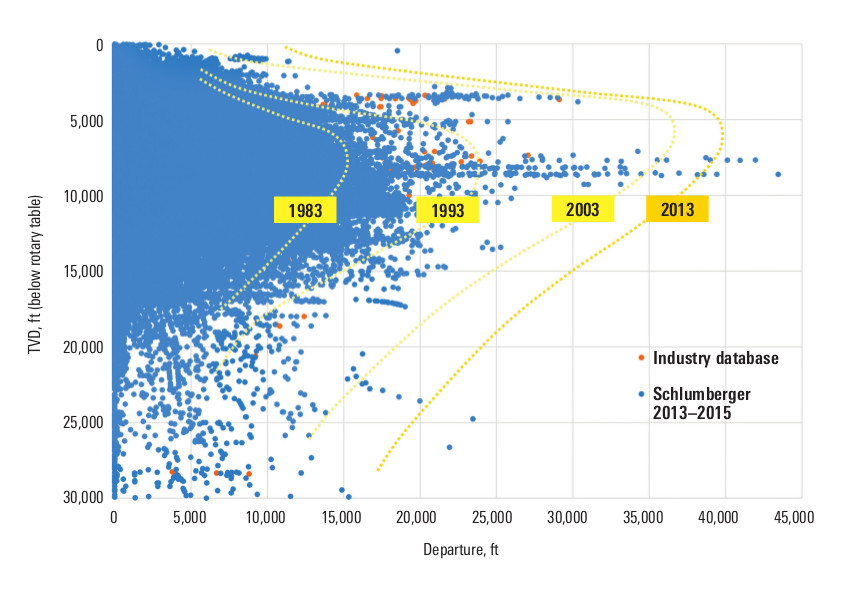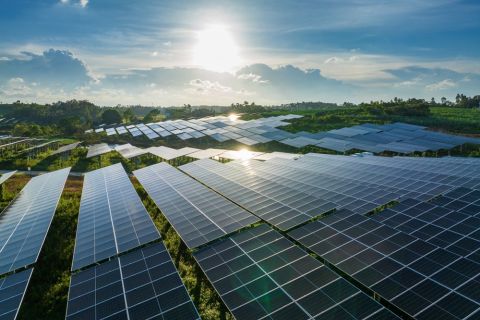With the decline of “easy oil,” the industry has made significant breakthroughs in unlocking reserves and maximizing return on investment in the fields that present a multitude of challenges and where the cost of failure is especially high. Among the techniques that have opened up opportunities in these plays is extended-reach drilling (ERD).
ERD services usually involve drilling and completing longer and more complex wells to improve the overall field development economics by overcoming challenges such as surface location restraints, weather and environmental conditions, high infrastructure costs, and low reservoir contact.
However, the longer wells invariably make the drilling process more difficult and involve additional uncertainties. Rotary steerable systems (RSS), a key enabler of ERD, rely on MWD, LWD and other downhole devices to drill long deviated wells through often rugged conditions for extended periods of time.
While these systems significantly boost drilling performance, executing a good-quality ERD well for completion also dictates that the wellbore be precisely positioned— geometrically and geologically—in the reservoir. Data transmitted from the bottomhole assembly all the way back to surface along increasingly longer trajectories must be reliable. Downhole tools have to be robust enough to withstand extended exposure times in harsher environments than in wells with more conventional profiles.
To address these multiple ERD challenges, Schlumberger has developed an integrated systems approach that starts with the engineering and design of the well and continues through the execution phase. Central to this capability is the PowerDrive RSS portfolio, encompassing a broad array of fully rotating RSS steering options designed to meet the complexities of every well environment. These drilling systems are enhanced with sophisticated telemetry, surveying and geosteering tools to ensure longevity, reliability and proper directional control. The approach has been used successfully to achieve several global ERD records (Figure 1).

Maximizing drilling performance
In 2015 a major Middle East operator embarked on an ambitious ERD exploratory well project that required navigating through problematic formations with high temperatures and in very abrasive conditions. The multifaceted project integrated expertise and fit-forpurpose technologies from multiple disciplines including fluid solutions, drilling tools, wireline and well services to drill the optimum well trajectory.
Extensive planning comprised the bottomhole dynamics analysis: downhole temperature, a geomechanics study for downhole pressure management, equivalent circulating and static density (ECD), and designing the drillstring for managing torque and drag. Beyond the challenges found in the topmost sections where the curve was built, the 8 3⁄8-in. ERD section was engineered to achieve maximum wellbore stability and hole cleaning. The 5 7⁄8-in. reservoir section, with temperatures exceeding 149 C (300 F), was identified as especially harsh and abrasive.
In overcoming these challenges, the PowerDrive vortex-powered RSS was run in all sections to maximize drilling performance, lessen the effects of severe drilling dynamics and provide a wide circulation envelope by using a fit-for-purpose steering mechanism to optimize the mud weight while drilling. Also deployed were the CLEAR hole-cleaning and wellbore risk reduction service, FLAG fluid loss and gain detection service, and FLAIR real-time fluid logging and analysis service to ensure proper wellbore integrity and hole-quality monitoring through advanced surface logging techniques.
In concert with these technologies, the PowerDrive Orbit RSS was implemented to set a global record for drilling the longest ERD well with temperatures above 149 C. This RSS uses actuation pads designed with metal-to-metal seals to tolerate corrosive drilling fluids, high temperatures and challenging well profiles at speeds up to 350 rpm while maintaining directional control and consistent steerability. A multiaxial direction and inclination package provides automatic hold inclination and azimuth capability for precise well positioning, while the self-steering capability delivers advanced performance by eliminating interaction with the rig equipment.
All drilling runs met the required objectives without downhole equipment failures or HSE issues, even during the high-temperature interval. Total depth of the well was reached in half the planned drilling time, representing a month of savings for the operator.
Operational efficiency in Alaska
In the Nikaitchuq oil field on the North Slope of Alaska an integrated approach has been the key to improving operational performance in drilling more than 50 multilateral ERD wells over 304,800 m (1 million ft). By developing a successful engineering process that combined several advanced systems and improvements, the operator was able to redefine the technical limits of the overall drilling operation. Key milestones involved overcoming uncertainty and abrasion wear resulting from a high-angle wellpath geometry in the intermediate hole section of a shallow ERD well and effectively using geosteering and surveying tools for wellbore positioning. The 12 ¼-in. intermediate section was drilled to 4,192 m (13,754 ft) measured depth in one run, a record for Alaska (Figure 2).

The PowerDrive Xceed ruggedized RSS drilled whipstock exits on five wells, replacing the conventional threerun approach. The system drilled ahead and deviated from the bottom of the milling rathole below the whipstock and window. Implementation of the RSS whipstock exits eliminated about five days of rig time. Designed for highly abrasive environments and minimum wellbore dependence, the point-the-bit system changes the direction of the bit by orienting the bit’s main shaft, overcoming the limits of conventionally steered systems.
Navigating the high-angle section was achieved with the PeriScope HD multilayer bed boundary detection service, which uses advanced measurements to accurately detect formation layers and reduce uncertainty with bed boundaries and fluid contacts. The tool’s ability to provide azimuthal gamma ray, multidepth resistivity, deep azimuthal images and annular pressure-while-drilling are essential inputs for quantitative formation evaluation and ECD analysis that optimizes hole cleaning.
An accurate directional surveying capability was crucial for maintaining an optimum drainage spacing, avoiding the risk of colliding with another well, particularly in the Arctic environment. Use of the Schlumberger WellDefined drilling survey services portfolio delivered both an optimized well path and along with the right tools saved about 10.5 hours of rig time per well, or 22 days of rig time over the 50 wells.
Planning, systems approach in Australia
Beyond technology, a systematic and integrated approach that takes into account the well profile, rig capability, fluids and hole sizes is an indispensable component of a successful ERD project. Close collaboration starting with the early conception phase, and oftentimes training, is essential for ensuring that all aspects of the well design are considered in the planning and execution stages of each well.
That strategy proved effective for an operator in its first ERD campaign in southeast Australia. The project involved accessing offshore reserves using an onshore drilling and production infrastructure to reduce development costs and avoid working in sensitive marine environments.
For this project, K&M Technology Group, a Schlumberger company specializing in ERD services, provided upfront engineering, project-specific training and supervision throughout the technically challenging operation. The drilling engineering consulting work included redesigning one well to eliminate problems during execution.
Collaboration from early planning to execution was instrumental in successfully drilling and completing three ERD wells that intersected all subsurface targets within the prescribed tight tolerances, setting two regional records in less time than planned and within budget. Single-bit run hole sections also were proved possible without any significant technical nonproductive time events. At 6,015 m (19,734 ft), one well is the longest onshore-to-offshore well drilled in Australia and ranks in the industry’s most difficult ERD category.
Recommended Reading
Baker Hughes Wins Contracts for Woodside’s Louisiana LNG Project
2024-12-30 - Bechtel has ordered gas technology equipment from Baker Hughes for the first phase of Woodside Energy Group’s Louisiana LNG development.
SM Energy Adds Petroleum Engineer Ashwin Venkatraman to Board
2024-12-04 - SM Energy Co. has appointed Ashwin Venkatraman to its board of directors as an independent director and member of the audit committee.
J.P. Morgan, Capital One Commit $260MM to Arizona Solar Project
2024-10-15 - Arizona’s Box Canyon solar project secured a $260 million tax-equity financing commitment from Capital One and an affiliate of J.P. Morgan.
US Energy Secretary Nominee Chris Wright Champions Energy at DUG GAS
2024-11-19 - President-elect Donald Trump's energy secretary nominee Chris Wright championed energy's role in bettering human lives earlier this year on stage at Hart Energy’s DUG GAS Conference and Expo.
Natron Energy Appoints New CEO
2024-12-17 - Sodium ion battery technology company Natron Energy has appointed Wendell Brooks as the company’s new CEO to lead growth initiatives in 2025.
Comments
Add new comment
This conversation is moderated according to Hart Energy community rules. Please read the rules before joining the discussion. If you’re experiencing any technical problems, please contact our customer care team.





